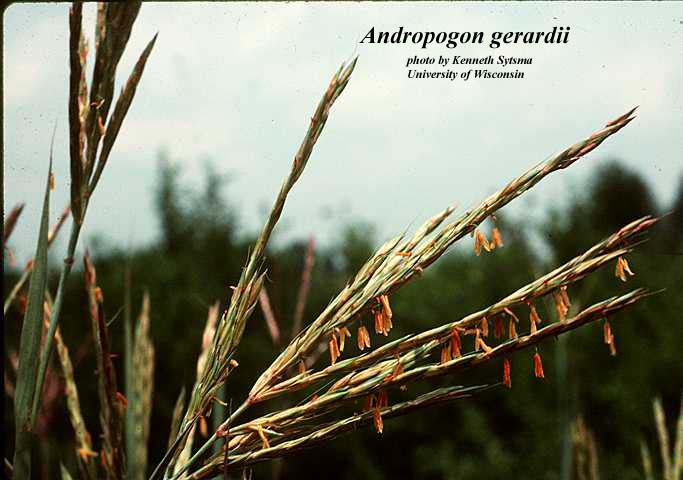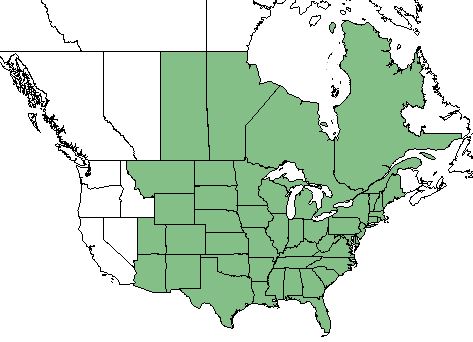Difference between revisions of "Andropogon gerardii"
(→Conservation and Management) |
(→Ecology) |
||
| Line 32: | Line 32: | ||
===Habitat=== <!--Natural communities, human disturbed habitats, topography, hydrology, soils, light, fire regime requirements for removal of competition, etc.--> | ===Habitat=== <!--Natural communities, human disturbed habitats, topography, hydrology, soils, light, fire regime requirements for removal of competition, etc.--> | ||
Big bluestem can be found in prairies, open woods, along riverbanks, meadows, and even roadsides. It is particularly abundant in lowland prairies and sandy areas <ref name= "USDA"/>. | Big bluestem can be found in prairies, open woods, along riverbanks, meadows, and even roadsides. It is particularly abundant in lowland prairies and sandy areas <ref name= "USDA"/>. | ||
| − | |||
===Phenology=== <!--Timing off flowering, fruiting, seed dispersal, and environmental triggers. Cite PanFlora website if appropriate: http://www.gilnelson.com/PanFlora/ --> | ===Phenology=== <!--Timing off flowering, fruiting, seed dispersal, and environmental triggers. Cite PanFlora website if appropriate: http://www.gilnelson.com/PanFlora/ --> | ||
| Line 41: | Line 40: | ||
<!--===Fire ecology===--> <!--Fire tolerance, fire dependence, adaptive fire responses--> | <!--===Fire ecology===--> <!--Fire tolerance, fire dependence, adaptive fire responses--> | ||
<!--===Pollination===--> | <!--===Pollination===--> | ||
| − | + | ===Use by animals=== <!--Herbivory, granivory, insect hosting, etc.--> | |
| + | ''A. gerardii'' is utilized by birds and mammals for nesting and escape cover during the summer and winter, and contributes to the spring nesting habitats since it resists lodging under snow cover <ref name= "USDA"/>. | ||
<!--==Diseases and parasites==--> | <!--==Diseases and parasites==--> | ||
Revision as of 18:09, 22 May 2018
| Andropogon gerardii | |
|---|---|

| |
| Photo by the Atlas of Florida Plants Database | |
| Scientific classification | |
| Kingdom: | Plantae |
| Division: | Tracheobionta |
| Class: | Liliopsida - Moncots |
| Order: | Poales |
| Family: | Poaceae |
| Genus: | Andropogon |
| Species: | A. gerardii |
| Binomial name | |
| Andropogon gerardii Vitman | |

| |
| Natural range of Andropogon gerardii from USDA NRCS Plants Database. | |
Contents
Taxonomic Notes
Synonyms: Andropogon gerardi Vitman, Andropogon provincialis Lamark, and Andropogon furcatus Muhlenberd ex Willdenow
Varieties: none
Description
Also known as big bluestem, A. gerardii is a native perennial graminoid that is a member of the Poaceae family. It is tufted, and contains short, scaly rhizomes. It is known for being a tall graminoid, ranging from 6 to 8 feet tall, and is very leafy at the basal region with some leaves that are carried up on the stem [1].
Distribution
A. gerardii is distributed across the United States and Canada, but not past New Mexico or Montana [1].
Ecology
Habitat
Big bluestem can be found in prairies, open woods, along riverbanks, meadows, and even roadsides. It is particularly abundant in lowland prairies and sandy areas [1].
Phenology
A. gerardii flowers from August until October [2].
Use by animals
A. gerardii is utilized by birds and mammals for nesting and escape cover during the summer and winter, and contributes to the spring nesting habitats since it resists lodging under snow cover [1].
Conservation and Management
For management, A. gerardii has a considerably weak seedling compared to its competition, so control of its competition is necessary, such as high mowing for weed control or even grazing of competing cool season grasses before the big bluestem is 1 inch tall in the spring [1].
Cultivation and restoration
There are several cultivars available of A. gerardii, including 'Bison' (ND), 'Bonilla' (SD), 'Champ' (NE, IA), 'Kaw' (KS), 'Earl' (TX), 'Niagara' (NY), 'Pawnee' (NE), and 'Rountree' (IA) [1].
Photo Gallery
References and notes
- ↑ 1.0 1.1 1.2 1.3 1.4 1.5 USDA Plants Database URL: https://plants.usda.gov/core/profile?symbol=ANGE
- ↑ Panflora URL: http://www.gilnelson.com/PanFlora/